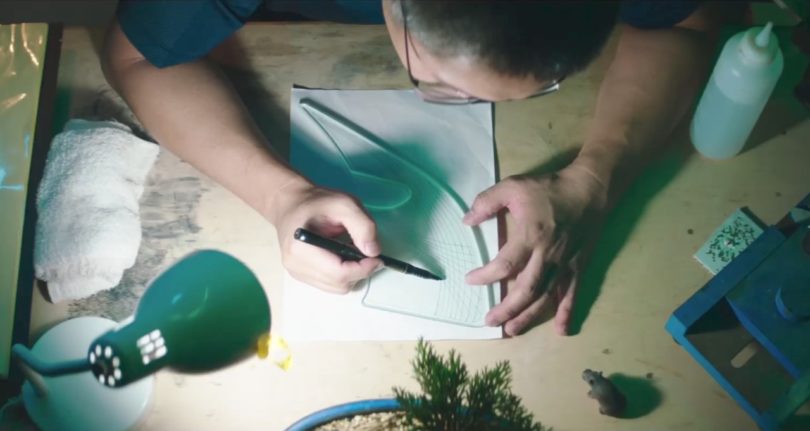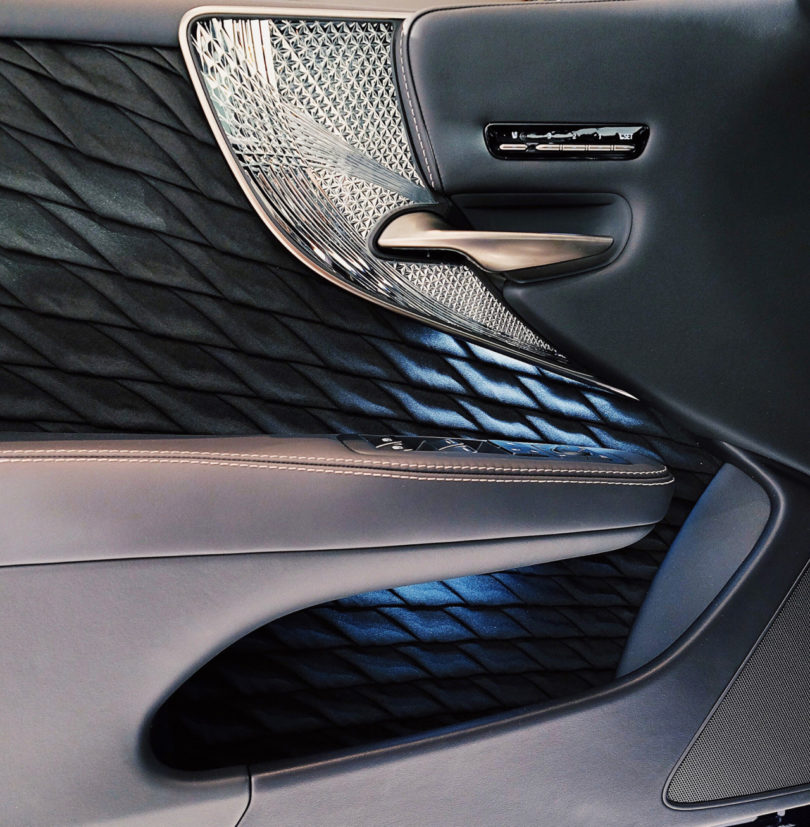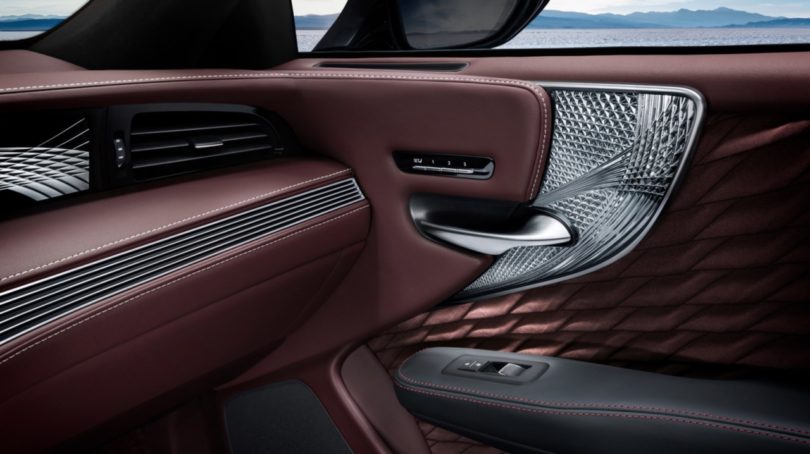How does a brand continue redefining a distinct expression of luxury in an era of continual commodification, marketing, and globalization? Materials? Aesthetics? Technology? The answer: all of the above. Exclusivity and accessibility are no longer solely linear, and luxury brands must carefully weave an imaginative helix that looks beyond mere iteration. Nowhere is this more evident than in the luxury automotive segment where functional design must also wear evidence of thoughtful craft and exceptional materiality.
Design Milk recently interviewed Lexus interior designer Junko Itou, exploring her part in shaping the recently launched flagship LS sedan’s sumptious detailing, alongside a discussion about tent poles of the Lexus design culture in pursuit of delivering modern luxury.

Lexus interior designer Junko Itou explains how each material choice becomes a statement and representation of the brand’s commitment to omotenashi, the Japanese “spirit of hospitality”.
Accompanied by a small collection of both raw and finished materials, Itou walked us through the interior details of the 2018 Lexus LS 500, explaining the procedural underlining that the Lexus design teams utilize to explore, identify, and execute the theme of luxury through materials.
From Junko Ito, Lexus Interior Designer:
I define luxury as the thing that enriches our spirit…the things that move us and allows us to enjoy peaceful time. As a result, I continuously try to embody L-finesse, our design philosophy incorporating the concepts of leading-edge and finesse.
Itou points out every surface and corner of the newest LS is conceived as an expression of the automotive brand’s willingness to explore unconventional materials to achieve unconventional luxury: hand-pleated fabric inspired by the highest level of origami, laser cut patterned wood surfaces, intricately patterned Kiriko cut glass. Each began as a handmade example, refined over numerous iterations with the purpose of producing a reproducible manufactured part retaining the original handmade quality and spirit. The sum is an interior cabin where sight and touch are engaged whether in a state of stasis or motion. The evidence of handmade care and craft remains even once transitioned to manufacturing, thus becoming a statement of luxury.

Lexus turned to 19th century Japanese craftsman techniques as the inspiration and framework to materialize their commitment to Takumi design – the highest level of accredited craftsman working within the Lexus design and manufacturing process. It is this team of specialized fastidious eyes charged to initiate and follow the highest degree of aesthetic detailing in service of the brand’s current and future designs.
Is there any friction in the process of bridging tradition with the necessity of innovation?
Junko Itou: No. While I admit there is difficulty in simultaneously working between tradition and progress, I find the conflicting elements can ultimately create harmony. We believe that we are the brand who always overcomes these difficulties. It is Lexus. We believe the definition of luxury changes over time, and it is our mission to balance traditional and visionary luxury.
There seems to be a material narrative across every panel and surface inside your design – distinct yet coexisting harmoniously. What was the process in determining which materials to use and how to coordinate their coexistence without creating visual/tactile disharmony?
Junko Itou: We’ve been thinking how we can make things seem conflicting, yet compatible at a high level when choosing each material. Also, choosing materials in line with interior designer’s intention is paramount. To coordinate the coexistence of several materials, we began by formulating three concepts: Superior, Emotional, and Timeless. Based on each of those themes, we selected color, material and finish as our focus. As the idea of the LS interior world became clear, we were able to coordinate the appropriate color, material and finish, even if it seemed difficult. Additionally, Takumi craftsmanship was necessary to complete it.
Automobile design has reached a critical crossroad where technological techniques have becoming paramount to manufacturing. What place do you believe genuine craftsmanship still has in the narrative of a luxury brand?
Junko Itou: Our designers continuously seek to achieve genuine craftsmanship. The technique of Takumi artisans, such as Kiriko cut glass and Hand pleats, as well as the discipline of skilled factory worker come from their desire to create good products in the world.
It seems like a diametric challenge, considering the value of craftsmanship relies upon a conscious/subconscious appreciation for the imperfections while manufacturing a car requires consistency…
Junko Itou: It is a challenge considering the value of craftsmanship to manufacture a car, but we don’t think it is diametrically opposed. The LS interior successfully combines handcrafted material such as the hand pleats, with industrial products such as plastic panels. We achieved this by sharing the will to create good products with all the parties through suppliers.
I found it interesting Lexus makes it an open intent to rewrite public perception about the brand. It was mentioned that while European luxury brands have countless decades of history connected to luxury, Japanese automotive brands remain respected technically, but not deemed on par in the luxury segment. This seems curious considering Japan’s deep and inherent craftsman history. How does one redirect this perception since it’s culturally and historically based? Is humility a roadblock here?
Junko Itou: As a Japanese car manufacturer it is true that we do not possess the same history as European luxury brands. However, we continue to challenge this perception and strive through our own technique and passion to create great products. We don’t think humility is a roadblock. Humility is to be respectful and considerate of others. To achieve our philosophical goals we understand we need to collaborate with many associates, and the importance of considering various perspectives to ultimately create something great.

Weeks ago Design Milk also attended the Tokyo Motor Show 2017, where Lexus unveiled the autonomous technology equipped Lexus LS+ concept, a model planned for an introduction by 2020.
Automotive cabins are moving toward large displays and other technological options while eliminating many of the tactile controls and displays that defined automobiles for decades. Do you consider this a bane or boon for automotive interiors?
Junko Itou: It is neither bane nor boon, but rather, a necessity. This has been the case for decades. Considering this is the basis as well as the objective, we are working to coordinate both luxury and technology.
Out of curiosity, how would you describe your home decor? Since you’re responsible for designing automotive interiors, is your home reflective in any way to the car interiors you design?
Junko Itou: I have lived in a traditional Japanese house since I was little. However, I enjoy elements that bring a unique feel to my home. While I maintain a fairly customary feel therein, I reluctantly removed the traditional Japanese flooring (Tatami) and replaced with a more modern style. I have grown to truly welcome this change, discovering that as I bring new items into my home, an inviting ambiance radiates with the traditional items already there. I also enjoy collecting antique wooden furniture because of the unique design portrayed over time in the wood grain as the color changes year by year.
Ultimately, I identify with design that aligns with a lifestyle of being connected with art, craftsmanship, travel and the beauty of this world.
from Design MilkDesign Milk https://design-milk.com/lexus-interior-designer-junko-itou/
from Home Improvment http://notelocreesnitu.tumblr.com/post/168326150714







No comments:
Post a Comment